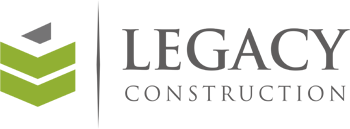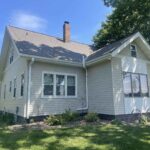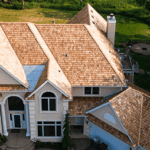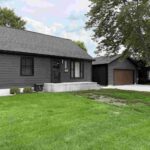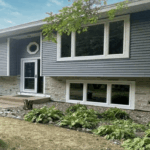When it comes to protecting your Minnesota roof, few features work harder than your shingles. Between hail, high winds, heavy snow, and freeze-thaw cycles, your shingles endure more stress here than in many parts of the country. It’s no surprise that many homeowners eventually ask our team if high-end roofing shingles are worth the cost.
The answer depends on your home, your budget, and how long you plan to stay there. For many Minnesotans, premium shingles deliver measurable long-term value. How? There are significant differences between Class 3 and Class 4 shingles, especially when compared to common roofing materials. The short answer: higher-quality shingles perform better in our state’s demanding climate.
Understanding Impact Resistance: Class 3 vs. Class 4 Shingles
Impact resistance ratings are one of the most important differences between standard and high-end shingles, especially in Minnesota, where hail and wind damage are common.
Shingles are tested and rated by Underwriters Laboratories (UL 2218) to determine how well they resist impact damage from hail. The scale ranges from Class 1 to Class 4:
- Class 1: Withstands a 1.25-inch steel ball dropped from 12 feet.
- Class 2: Withstands a 1.5-inch steel ball.
- Class 3: Withstands a 1.75-inch steel ball.
- Class 4: Withstands a 2-inch steel ball.
In other words, Class 4 shingles offer the highest level of impact resistance, making them the top choice for homeowners in hail-prone regions.
The Benefits of Class 4 Shingles
- Superior durability: they are designed to resist cracking, granule loss, and punctures from hail.
- Longer lifespan: they can last 30–50% longer than standard shingles.
- Potential insurance discounts: some insurers offer premium reductions for Class 4 roofs due to their proven durability.
- Less maintenance and repair: fewer post-storm issues mean fewer insurance claims and out-of-pocket costs.
While Class 4 shingles cost more upfront (often 15–25% higher than standard asphalt shingles), their longevity and reduced risk of storm damage often make them the more cost-effective choice over time.
Asphalt vs. Wood: Comparing Materials
Beyond impact resistance, the type of material you choose has a major effect on both cost and performance.
Asphalt Shingles
The most common roofing material in Minnesota, asphalt shingles are available in several styles and quality levels, including Class 3 and Class 4 options.
Pros:
- Cost-effective: Asphalt is more affordable than wood, slate, or metal.
- Versatile: Comes in many colors and styles, including architectural and designer shingles that mimic the look of wood or slate.
- Low maintenance: Requires minimal upkeep compared to natural materials.
- High performance: Premium Class 4 asphalt shingles can withstand hail, heavy snow, and high winds. This is ideal for Minnesota’s climate.
Cons:
- Shorter lifespan: Typically lasts 20–30 years (though Class 4 varieties can last longer).
- Heat sensitivity: Prolonged heat exposure may shorten lifespan, though this is less of a concern in northern climates.
Wood Shingles and Shakes
Wood shingles offer a natural, timeless appearance that many homeowners love, particularly on historic or craftsman-style homes.
Pros:
- Aesthetic appeal: Adds warmth, texture, and curb appeal.
- Natural insulation: Wood provides good thermal performance, helping regulate attic temperatures.
- Longevity with proper care: Cedar shakes, when properly maintained, can last 30–40 years.
Cons:
- Higher cost: Material and installation costs are typically much higher than asphalt.
- Maintenance requirements: Must be treated to resist rot, insects, and mold — especially in humid or wet climates.
- Fire risk: Wood shingles are less fire-resistant unless treated.
- Hail vulnerability: Even treated cedar can be damaged by hail, making it less ideal for areas prone to severe storms.
For most Minnesota homeowners, Class 4 asphalt shingles provide the best balance of cost, performance, and protection, while wood shingles remain a great choice for those willing to invest in maintenance and upkeep.
High-End Shingles Perform Well in Minnesota’s Climate
Minnesota’s weather patterns are hard on roofing materials, which is exactly why investing in higher-quality shingles can pay off.
Winter Performance
- Freeze-thaw cycles can cause cracking and granule loss in lower-grade shingles.
- Premium Class 4 shingles are engineered to maintain flexibility in cold temperatures, reducing the risk of brittleness and cracking.
- Proper attic ventilation and underlayment help prevent ice dams and moisture buildup.
Summer Heat and UV Resistance
- High-end shingles often include UV-resistant coatings that slow color fading and protect against asphalt breakdown.
- Cool-roof technologies can reflect sunlight, keeping homes cooler and reducing energy costs.
Storms and Wind Resistance
- Many Class 4 shingles are rated to withstand winds up to 130 mph.
- Their reinforced layers and stronger adhesive strips prevent shingles from lifting or blowing off during high winds.
- Impact-resistant granules help reduce visible damage from hailstones.
Simply put, premium shingles outperform standard shingles when it comes to longevity and protection in Minnesota’s unpredictable climate.
Cost vs. Value: Is the Upgrade Worth It?
When you upgrade to a high-end roofing system, you’re investing in longevity, performance, and peace of mind.
Standard asphalt shingles are the most affordable option, typically lasting 20 to 25 years and offering moderate resistance to hail and wind. Class 3 shingles cost a bit more but provide improved impact resistance, a lifespan of around 25 to 30 years, and may occasionally qualify for insurance discounts.
At the top of the spectrum are Class 4 shingles, which deliver superior protection against hail and high winds, require very little maintenance, and can last 30 to 40 years or more. While they carry the highest upfront cost, homeowners in storm-prone areas often find that the extended lifespan, reduced need for repairs, and potential insurance savings more than make up for the difference, especially after a few harsh Minnesota seasons.
Tips for Choosing the Right Shingle for Your Home
- Assess your home’s exposure. If you live in an area prone to hail or strong winds, Class 4 shingles are worth the investment.
- Consider long-term value. If you plan to stay in your home for 10+ years, premium shingles typically pay for themselves through longevity and fewer repairs.
- Check with your insurance provider. Some companies offer discounts for Class 4-rated roofs. Always ask before installation.
- Work with a local, certified contractor. Proper installation is just as important as the product itself. Choose a trusted Minnesota roofer who understands local weather conditions and can install your new roof to manufacturer standards.
Why Homeowners Choose Legacy Construction
At Legacy Construction, we do more than replace roofs — we protect homes, families, and investments. Our team will:
- Evaluate your current roof’s condition honestly.
- Explain your shingle options in detail, including cost, performance, and appearance.
- Recommend the best solution for your home and budget.
- Handle installation with precision and care, so your new roof performs exactly as it should.
As a local, family-owned roofing company, we’ve earned a reputation throughout the Twin Cities for honest advice, quality workmanship, and storm-tested results. Whether you’re considering a durable Class 4 asphalt shingle or a beautiful cedar roof, you’ll get clear communication and craftsmanship that lasts.
 (952) 303-4080
(952) 303-4080



